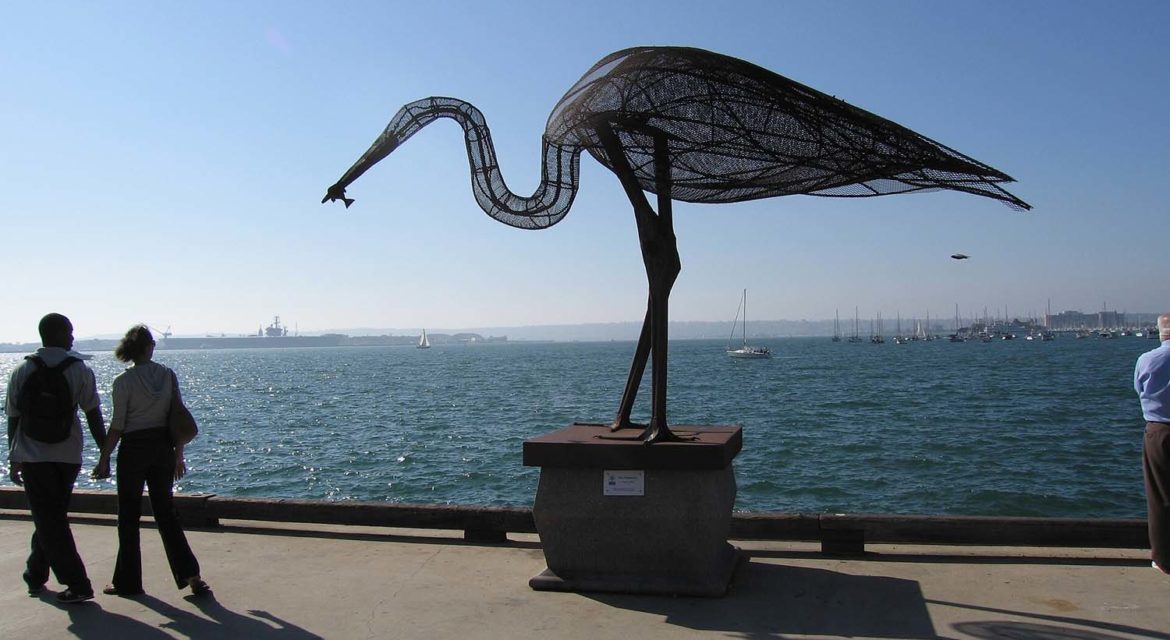While it might not be a stated priority, there are few sculptors who would deny that creating a piece that becomes iconic isn’t somewhere in the back of their mind. The notoriety that something like “The Bean” or “Spoonbridge and Cherry” represents for a sculptor’s career is undeniable, but the impact that such pieces have had on their surroundings and communities is even more notable. Artists like Stephen Fairfield recognize the actual and potential impact of their work on both of these levels.
Fairfield is a full-time artist with some 40 years of experience. His company, Fairfield Enterprises, specializes in creating energetic & engaging sculptures that enhance public & private spaces both day and night. For the past 16 years he has been focused on creating new media and steel public art sculptures. He has public art creations in San Diego and Sonoma, CA, Green Bay, WI, Tucson, AZ and Roanoke, VA, and other locations across the country.

His stated goal with his work is to create sculptures that make participants from observers and creates dynamic tension and motion. In doing so, his pieces have enabled engagement with the communities where they’re installed to provide economic and social benefits that extend to stakeholders and beyond. To highlight what kind of a difference doing so can represent for both artists and communities, I connected with Fairfield to discuss his process, how he works to facilitate experiences for viewers, what kind of literal difference he’s seen his pieces enable and much more.
Jeremiah Karpowicz: I want to get specific about the differences you’ve seen your pieces make to cities and communities, but before we get to that, can you talk a little but about how you consider the surrounding elements of those communities for a given piece?
Stephen Fairfield: The nature of the call is where it all starts. If it’s a university it might be something that’s tied to the nature of the piece. We’ve submitted proposals at universities that have an aeronautical engineering site and they want it to be related to that. So it can be in response to who the players are.
In a municipality, I’ve submitted pieces and have been accepted where there’s been a theme. For one, the theme was “capricious”. I’ve submitted ideas for pieces that need to meet specific requirements associated with a space. So it might not be able to be more than 20 feet high, or weigh more than 5,000 pounds, etc.
There’s a limit to how much you can let all of that influence an idea though. Trying to figure out what someone wants almost never works. At least for me! The bottom line is that I go with what I want to make. I’ve gotten to the point where I read the call, consider the various parameters and then get inspired about what I perceive would work in that space, and for that audience. If they don’t like it, that’s okay.
That makes sense, as I imagine you don’t want to put yourself or a potential client in a position where you’re making something that doesn’t really line up with your vision or they’re moving forward with an idea that isn’t something they really want.
Yes, because in all cases, you have to be true to yourself. There’s no motivation to make a piece that doesn’t say who you really are. Sometimes, that can be contrary to what people want and even what they envision.
I’ve run into situations where I’ve been confronted by review committees that are expecting me to go down a particular track, so they didn’t really want me to do anything that went beyond my established body of work. I’ve had some rough confrontations with people who will come back and tell me that a given idea isn’t my real vision, but I don’t get too caught up in that sort of thing anymore. It’s got to come down to who you are as an artist and what you’re trying to say.
I expect artists to evolve in what they’re trying to say.
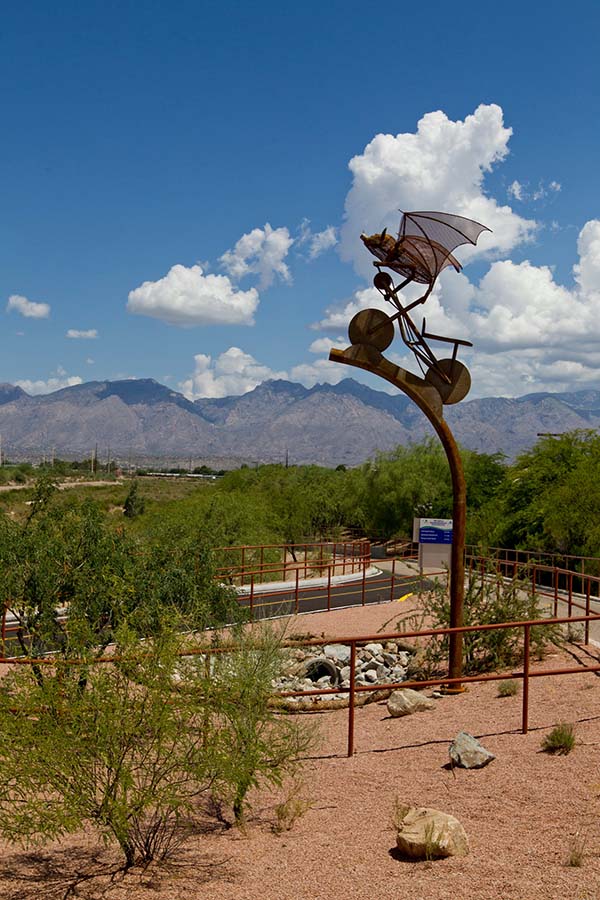
That concept of what happens with review committees is something I wanted to explore with you. More and more communities are speaking out against public art pieces that have or will be installed, so generally speaking, how reflective of a community are these committees?
Conceptually, the committees are supposed to be made up of actual members of the community in one capacity or another, but it’s hard because nothing is perfect and every city/committee/community is different. That’s where I’ll give you a disclaimer and say I can only tell you about my experience, but it’s hard from a public artist’s perspective to not get at least somewhat jaded by some processes.
A review committee can include local politicians, someone from a city department, local artists, well-off residents, etc. All of which is to say these committees feature opinions about art that might not come from the most informed place. The adage about a camel being a horse designed by committee applies here, but on a whole different level. You might get 8-9 perspectives about what something should be, or there’s one voice that the rest of the committee passively supports, and that single voice might end up changing things for the worse.
You never know what you’re stepping into with this process or the people involved in it. A recent proposal for a new media interactive piece is a good example of that. The piece was vehemently supported by an “average” citizen from the neighborhood in which it was proposed to be sited. He said “I love this piece so much I’d take my morning walk and visit it, and bring my aluminum chaise lounge chair at night and just sit here and appreciate it changing colors and patterns.” Several other members of the 12 person review committee loved it as well. The outcome? At the conclusion of my presentation the public art staffer pronounced that “there would be no electronics in this particular location.” It developed that she was having a problem with an older new media sculpture’s electronics somewhere else in the city, couldn’t get it to work, and even though the call stated an interest in new media, she killed the idea. Parenthetically, I even proposed that our team’s electrical engineer and I would help her resolve the problems with that sculpture, but her pride persevered!
Public art isn’t generally at the cutting edge, because it’s more about what that cast of characters decides the community should be exposed to. Those kinds of unilateral decisions about what art “should be” often gives us some pieces that are not as inspiring as they could be and can result in the kind of pushback you’re talking about.
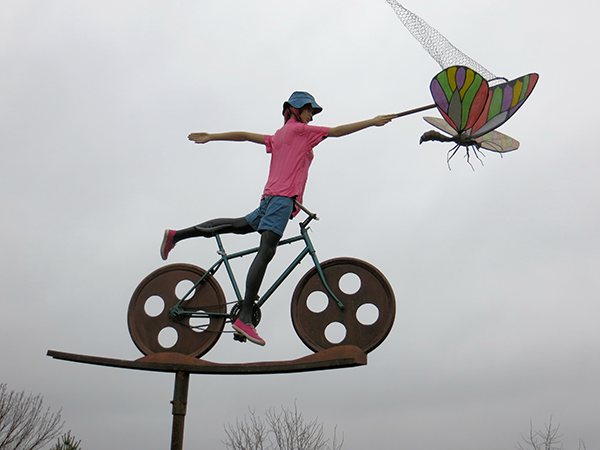
Exactly, which means that a decision that’s supposed to be reflective of an entire community is instead reflective of a single or limited perspective.
That’s true, but it’s also where things get complicated.
Any given community is comprised of a polyglot group of people, all of whom have different opinions about what public art should be, and whether it’s needed at all. Some will argue that instead of spending money for a given piece of public art, that money would be better spent on police or the homeless. That’s an argument we see more and more.
The problem is that most people making those arguments don’t understand the real numbers that are associated with all of these things. You can use whatever money you’d spend on a piece of public art to instead hire more police, but that kind of expense isn’t a fixed cost, and it conceivably continues on in perpetuity. That’s very different from the set costs associated with a piece of public art that are much better understood, controlled and managed.
Yes, but some people in a given community are always going to want to see such funds go to city services rather than public art, no matter what the numbers look like.
Absolutely, and I’m fine with that. I think it’s healthy for a community to encourage that kind of feedback. It’s up to the artists to determine how to cope with that mentality and pull people out of it. I’m currently in the midst of that.
Some of it is just about fundamental human behavior. Some people are never going to support the kind of things that we want to bring into the world, and some people are always going to specifically hate what you create. I’m fine with that too, and there are plenty of artists that are happy with that reaction because it means people are noticing it. We just want people to wake up and be part of what’s going on.
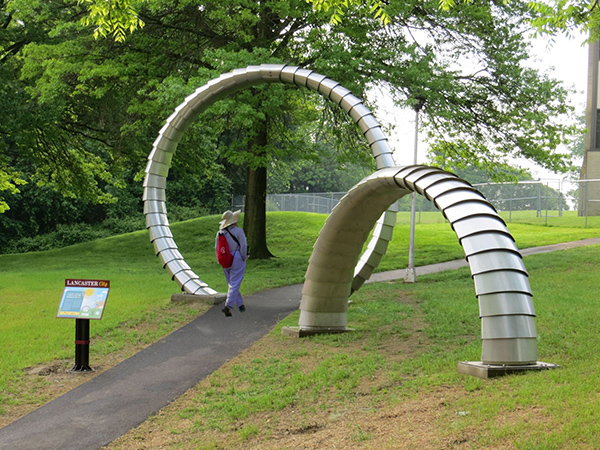
Encouraging people to be part of what’s going on with your pieces is clearly an active consideration, so maybe we can talk about what doing so has meant to the people and communities where your work has been installed. What can you say about what’s it’s meant for people to become part of what’s going on with “Revolutions of Brandon Park”?
That’s a good example of how these pieces can create engagement because it was so successful from a variety of perspectives. It’s an interactive new media public art sculpture in an inner-city public park in Lancaster, PA.
The original city staff person involved with that piece was and is at the cutting edge of art, which is why I felt comfortable proposing and building something that would be interactive. To me, successful public art sees a partnership between the artist, the community and the piece. It’s not complete unless the individuals in the community participate in that artistic expression. That’s why I try to dream up art that interacts with motion sensors to pick up people passing by and energizing the system. I try to reach people without giving them an instruction manual but make it more experiential and allow them to see that they can change the way a piece of art looks. They can affect it. They can be part of the artistic expression. And it’s fun. I want people to experience and enjoy it.
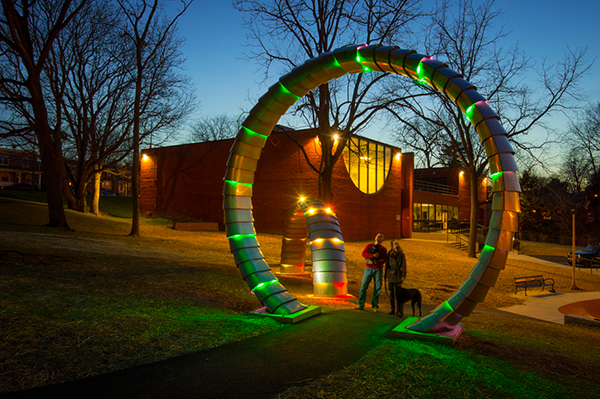
‘Revolutions’ is installed over a pathway that leads through Brandon Park from the neighborhood uphill to the local elementary school. There is a community center/senior center within the park, and multiple basketball day/night courts. People from early childhood to much later on in life are regularly exposed to this interactive, beautiful, colorful piece, and it has become part of the fabric of the community that passes through and uses the park. One unanticipated “interactive” outcome I hadn’t anticipated is that skateboarders have figured out how to skate up the inner sides of the sculpture and use it for their tricks! We anticipated energetic interaction of some sort, so fabricated it out of heavy stainless steel so it has held up well to this kind of use. I love it!
How have you seen those sorts of interactions embraced or serve as an attraction for a space or community?
It’s something you can see just by going to where these pieces have been installed and standing back and watch, which I have done. But it also comes back to me from feedback the people that are around it on a regular basis.
Another example of what this can look like is “Interactive Emersion”, which is a “message” installation in a 110 ft pedestrian tunnel underneath a main road in Green Bay. The Fox River had been polluted by the paper industry to the extinction of its fish, and then restored over the past 4 decades. The installation is next to the Fox River and is lined with 22 different large fish sculptures along the walls representing the restored fish species. The fish point in different directions, and utilizing motion sensors and LEDs as people move through the passenger tunnel, the fish light up in sequence and look like they’re swimming away. Since different people move at different speeds the experience is always going to vary and work better for some than others, but people do love it. The more they pass through, the more opportunities they have to experience it and see it differently.

Along those same lines, how have you seen pieces like “The Defender” and “Frog for Dinner” both influence the spaces they’ve been installed and create experiences for visitors?
“Frog for Dinner” is in Riverwalk Park in Green Bay along a path that’s well-traveled in the summer, so there are always people around to interact with it. I’ve seen kids go over to it and marvel up at it. They run back to their parents after having one of those “ah-ha” moments and that makes me happy. It goes back to how I like people to experience art where they’re at. It’s ultimately up to the viewers in terms of how they interpret it, and that experience has changed the space for the better, I think.
The piece has very much become part of the scene as it’s large enough to draw people to it and allows them to get involved with it in a personal way. Size does matter with sculptures because if something is sizable, you can’t ignore it. I like to make big, partly because it gives people an opportunity to see something at a scale they aren’t used to, and again, that impacts the space and viewers’ interpretations.

You can see much of that in “The Defender” as well. That piece is a draw for the space, but it’s more of a selective draw because you can’t just drive up to it. You have to walk over to it on a walking path because it’s in a nature preserve. So there’s a selectivity to it, and I think it will be a draw for the park because there’s a limited amount of art on display there. It’ll be part of the experience of being in the park.
“The Defender” is a “message” sculpture also in that it draws attention to a species of endangered bird – The Sandhill Crane – that migrates to Montana in the summer and nests in that particular preserve. In fact this past year the pair of cranes had two hatchling “colts” that were in the immediate vicinity of “The Defender”. I wanted to draw peoples’ attention to the wonders of nature around them, along with trying to elevate awareness of the need for ecological preservation.
I love hearing that, because allowing something to serve as a draw for a space or community feels like it’s not always top of mind for those review committees we talked about.
It depends, but it’s usually a consideration. However, other factors often take precedence in a given decision, and that’s unfortunate for everyone.
There are a lot of opportunities in the public space for art, and they’ve increased over time. In general, they’re linked to revenue generated from development. It’s a great thing, but unfortunately, these opportunities aren’t being considered in terms of how they can provide education to a community or as you mentioned, serve as a draw. Many decisions are tied to the turnover cycle of the elected officials, so someone might be committed to the public arts but then a new person comes in and doesn’t want to move forward with the groundwork that’s been laid. So there’s lot of stops and starts in the process.
Awareness about how important public art is for cultural awareness and economic development in society is important, and more communities are realizing that art is a good thing. The aesthetic taste and nature of a community can be complex, but they can quickly discover how worthwhile it is to do.
Ultimately, what does it mean to you to enable that discovery of the value public art can create for an entire community?
I love when it happens, because I know there’s a huge percentage of the country that will never go into an art museum or an art gallery. They just won’t do it. Many people don’t even notice the art galleries or art museums that are right there for them to experience. Being able to bring art to that audience is something I strive to do.
When I’m going for a commission in a community, I consciously and verbally state that I’m making art for the public. Sometimes that bombs, because certain people don’t agree with that position. I’ve seen people actually wince when I say those words. The comments I’ve gotten back about it is that “art isn’t for everybody.” They don’t want “art for the public,” they want something that’s for a certain audience, or from a very limited perspective.
Those decision-makers can do what they want, and I’m fine with it, because anyone who doesn’t want “art for the public” has a different philosophy than I do and nothing I can say is going to change their mind.
Seems like that sort of mentality is at the root of this pushback we’ve seen when communities reject existing or potential pieces of public art. It just feels like such a missed opportunity.
It is, especially when you know what it means to see those opportunities realized.
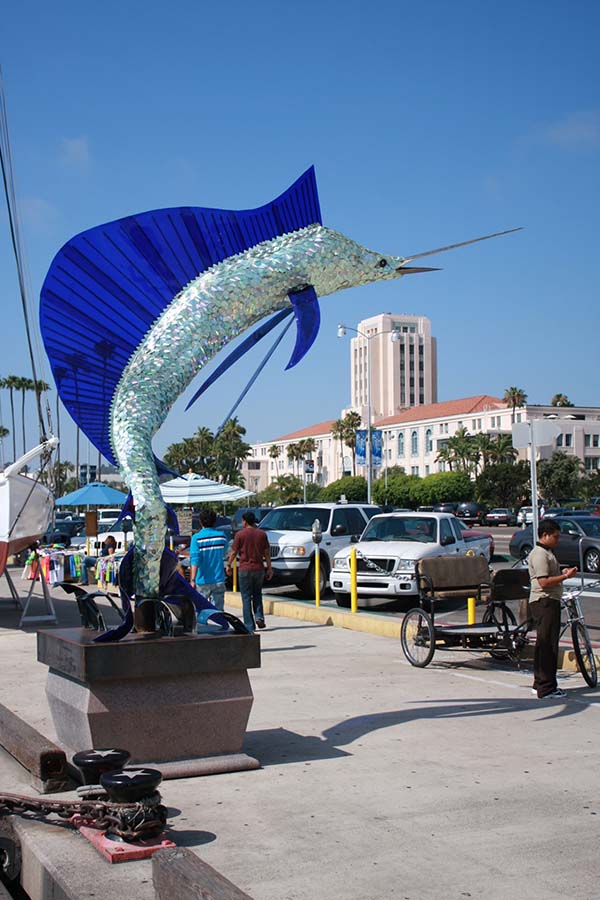
I remember watching a boy and his father come upon my “Tailwalking Suncatcher” sculpture, which was part of an annual exhibit in San Diego on the Embarcadero. The boy immediately started pointing at the piece and had a real emotional reaction to seeing it. He was just so thrilled. That’s a unique experience that he couldn’t have had in any other way. Maybe that boy won’t remember what made him feel that way, and the father won’t remember what spurred that emotion in his son, but the experience will be with both of them for the rest of their lives. That goes beyond any attempt to measure or quantify what public art can mean to a community.
There has to be a conduit to enable these kinds of experiences for communities as a whole. Not everyone is going to have the same kind of experience with any piece of art, but we have to provide as many opportunities to do so as we can, because there’s no other way for people to have them. And to me, that’s what it’s all about.
